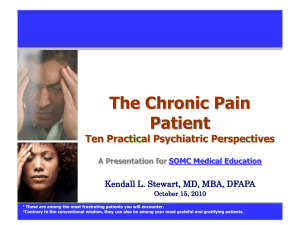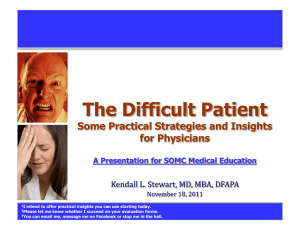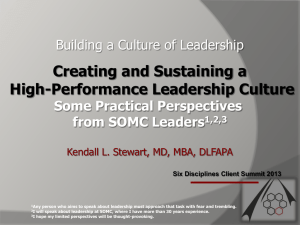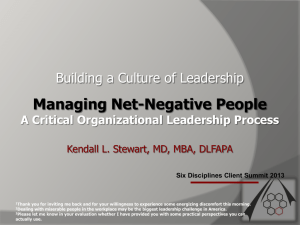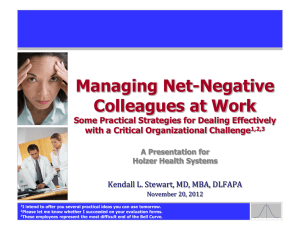Preparing Managers to Deal with Difficult People
advertisement
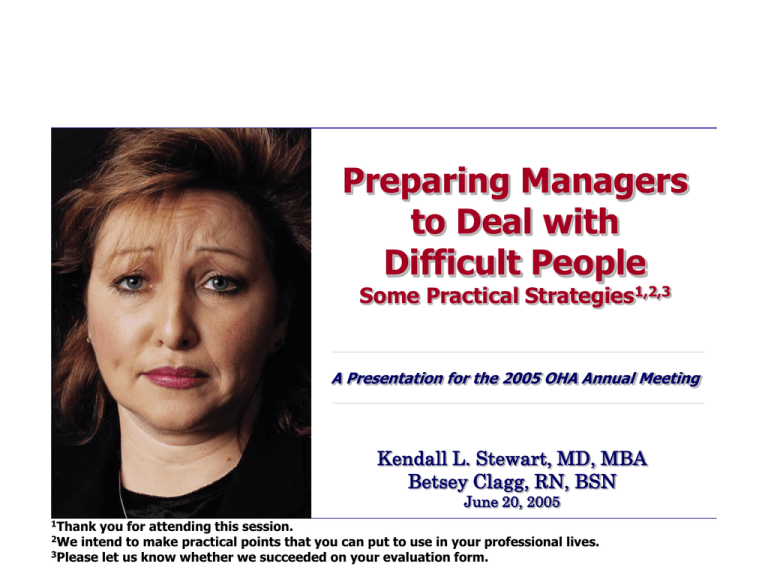
Preparing Managers to Deal with Difficult People Some Practical Strategies1,2,3 A Presentation for the 2005 OHA Annual Meeting Kendall L. Stewart, MD, MBA Betsey Clagg, RN, BSN June 20, 2005 1Thank you for attending this session. intend to make practical points that you can put to use in your professional lives. 3Please let us know whether we succeeded on your evaluation form. 2We Why is this topic important? • Difficult people are everywhere.1 • Dealing with them is a challenge for everyone, but these folk are particular challenges for organizational leaders. • SOMC leaders believe this is the most significant challenge they face in their professional lives. • Most of us don’t deal with difficult people very well. • We could do better, and we could prepare our managers to do better. • This presentation will suggest a number of practical strategies that will help you prepare your managers to deal more effectively with these “Phantoms of the Workplace” 1I mastering • After the information in this presentation, you will be able to – Describe how difficult people sometimes behave, – Explain how that behavior “makes” your managers feel, – Specify how those feelings compel your managers to react, – List three practical educational strategies that will assist you in preparing your managers to deal more effectively with difficult people. get the biggest kick out of dealing with snobs, particularly big-city snobs. Being from Portsmouth, I get such opportunities all the time. An executive from Columbus liked my tie. A psychiatrist from Cleveland was appalled that someone from Portsmouth would be appointed Chair of the OPA Ethics Group. What are some successful strategies for preparing managers for dealing with difficult people? • Acknowledge the extent of the problem. • Ask managers how difficult people behave. • Ask managers how difficult people “make” them feel. • Ask them how unpleasant feelings incline them to react. • Encourage more realistic expectations. • Detail practical strategies for dealing more effectively with difficult people.1 • Design and deploy effective educational activities. 1I • Engage managers in the learning process. • Arrange for opportunities to practice effective confrontation. • Focus on changing the manager’s behavior. • Promote team learning across departmental lines. • Document educational effectiveness. was trying to teach one of my male patients to be more romantic. I know what women want. I explained Hallmark™ cards to this man. You know what he did? What percentage of the problems SOMC leaders face are “people” problems? 20% 80% People Problems SOMC Leaders Focus Group, September 9, 2004 Other Problems How do the difficult people at SOMC behave? • • • • • • • • • • • • • They are negative. They avoid conflict. They are manipulative. They are pot-stirrers. They are selfish. They won’t take responsibility for their behavior. They are arrogant. They are disrespectful. They fall back into old behaviors. They are passive-aggressive. They are demanding and impatient. They deny their behavior. They disregard policy. They are unmotivated and lazy. Rank ordered by SOMC Leaders Focus Group, September 9, 2004 How do difficult people at SOMC “make” managers feel? • • • • • • • • • • • • • • • • SOMC Leaders Focus Group, September 9, 2004 Anxious Confused Defeated Defensive Desperate Determined Detached Disengaged Disappointed Embroiled Frustrated Helpless Impatient Inadequate Ineffective Intimidated • • • • • • • • • • • • • Mad or angry Nervous Overwhelmed Powerless Resentful Scared Sick Stressed Tired Apathetic Uncomfortable Unmotivated Withdrawn How may these feelings compel managers to react? • • • • • • • • • • • Behave aggressively Become arrogant Counterattack Seek out others who will commiserate Condescend Become defensive Become guarded Grovel Minimize the problem Become moody Become obsessive SOMC Leaders Focus Group, September 9, 2004 • • • • • • • • • • Placate the troublemakers Protect the victims Ruminate Regress to defensive inflexibility Behave rudely Scheme Seek affirmation of their perceptions Indulge in tantrums Ventilate destructively Withdraw What are some successful strategies for dealing with difficult people? • • • • • • • • • • 1It Label them.1 Neutralize them. Describe them. Predict them.2 Inform them. Involve them. Ignore them. Convert them. Avoid them. Expose them. • • • • • • • • • • Circumvent them. Use them. Persuade them. Confront them. Rehabilitate them. Discourage them. Ridicule them. Isolate them. Punish them. Extrude them. is critical to tell people “how.” I suggested that leaders use the mental image of a yellow sticky note. waste a lot of time hoping difficult people will change. People don’t change much. I recently took my wife to Hawaii to celebrate our 30th anniversary. We got out “The List.” 2We What approach did we use in designing the educational activity? • Leadership Development Team • Strategic Value Leadership Conference – Learn and share tools and techniques – Promote team learning across department lines • • • • Problem-oriented learning Focus on changing behavior – (indicators) Effective presenters High energy level What strategies did we use to engage managers? • Purposeful – useful strategies • Brevity • Humor • Storytelling • Informal setting • Provide food • Make it Fun – Theme - “SOMC Productions” What did we consider in designing our role play exercise? • Not a favorite method of learning • Non-threatening, “safe” environment • Reinforce classroom theory • Realistic scenarios • Clear expectations of outcomes • Heterogeneous vs homogeneous groups • Planned “debriefing” (processing) How did we engage the participants in the activity? • Theme - Getting into “character” • Triads: manager, employee, observer roles • “Scripts” for manager, employee • Observer role • Fully engage in activity – realistic • “Back stage” areas • Large group discussion What was our approach to processing the role play experience? • Completed a reaction form – – – – – What happened? How did you feel? Based on your feelings, what did you do? What was the reaction? What might have been done differently? • “Interviewed” individuals • Captured “best practices” • Applauded their acting debut How did we document the effectiveness of the education? • Completed an evaluation immediately following the course • Asked for a commitment to deal with a difficult person within 60 days • Reported on their experience and completed a followup evaluation in 60 days • Measured the percentage of those who applied the learning within 60 days • We asked managers to estimate the percentage impact this educational experience had on their actual leadership performance. What results did we see? • Attendees’ mean assessment score was 4.73 compared to previous mean evaluation scores of 4.5, 4.61, 4.54, and 4.56 following similar SOMC leadership workshops.1 • Written comments were overwhelmingly positive.1 • 71-percent of attendees applied their learning within 60 days.2 • Managers estimated their leadership performance had changed by 32.5% due to this education.3 1Workship evaluation return rate for the 60-day follow up survey was 30-percent. 3American Society of Training and Development assessment tool 2The Where can you learn more? • • Stewart, Kendall L., et. al. A Portable Mentor for Organizational Leaders, SOMCPress, 2003 S Stewart, Kendall L., “Physician Traps: Some Practical Ways to Avoid Becoming a Miserable Doctor” A SOMCPress White • Paper, SOMCPress, July 24, 2002 Stewart, Kendall L. et. al, “On Being • SOMCPress White Paper, SOMCPress, January 2001 Stewart, Kendall L., “Bigwigs Behaving • Paper, SOMCPress, March 11, 2002 Stewart, Kendall L., “Relationships: Building Successful at SOMC: Some Practical Guidelines for New Physicians” A Badly: Understanding and Coping with Notable Misbehavior” A SOMCPress White and Sustaining the Interpersonal Foundations of Organizational Success” A SOMCPress White Paper, SOMCPress, March 11, 2002 Please visit www.KendallLStewartMD.com to download related White Papers and presentations. How can we contact you? Kendall L. Stewart, M.D. Chief Medical Officer Southern Ohio Medical Center President & CEO The SOMC Medical Care Foundation, Inc. 1805 27th Street Portsmouth, Ohio 45662 740.356.8153 stewartk@somc.org Webmaster@KendallLStewartMD.com www.somc.org www.KendallLStewartMD.com How can we contact you? Betsey Clagg, R.N., B.S.N. Director, Staff Development Southern Ohio Medical Center 1805 27th Street Portsmouth, Ohio 45662 740.356.2412 claggb@somc.org What questions remain? www.somc.org Southern Ohio Medical Center Safety Quality Service Relationships Performance

